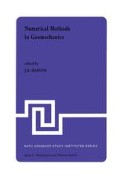Abstract
The present work deals with applications of the Boundary Element Method to several groundwater flow problems. Steady and transient cases are discussed; two-dimensional, axisymmetric and fully three-dimensional problems considered; it is also shown how features like orthotropy and anisotropy, piecewise homogeneous regions and semi-infinite regions can be included in the analysis. Several numerical examples are studied in order to show the wide range of groundwater flow problems which can be efficiently solved using the Boundary Element Method.
Access this chapter
Tax calculation will be finalised at checkout
Purchases are for personal use only
Preview
Unable to display preview. Download preview PDF.
References
M. A. Jaswon and G. T. Symm, Integral Equation Methods in Potential Theory and Elastostatics, Academic Press, London, 1977.
C. A. Brebbia, The Boundary Element Method for Engineers, Pentech Press, London, 19 78.
C. A. Brebbia and S. Walker, Boundary Element Techniques in Engineering, Newnes-Butterworths, London, 1980.
T. A. Cruse and F. J. Rizzo (eds.), Boundary Integral Equation Method: Computational Applications in Applied Mechanics, ASME, AMD-11, New York, 1975.
T. A. Cruse, J. C. Lachat, F. J. Rizzo and R. P. Shaw (eds.), First Int. Symp. on Innovative Numerical Analysis in Applied Engineering Science, CETIM, Versailles, 1977.
C. A. Brebbia (ed.), Recent Advances in Boundary Element Methods, Pentech Press, London 1978.
P. K. Banerjee and R. Butterfield (eds.), Developments in Boundary Element Methods, Applied Science Publishers, London, 1979.
C. A. Brebbia (ed.), New Developments in Boundary Element Methods, C.M.L. Publications, Southampton, 1980.
R. P. Shaw et al. (eds.), Innovative Numerical Analysis for the Engineering Sciences, University Press of Virginia, Charlotesvilie, 1980.
C. A. Brebbia (ed.), Progress in Boundary Elements, Vol. 1, Pentech Press, London, 1981.
C. A. Brebbia (ed.), Boundary Element Methods, Springer-Verlag, Heidelberg, 1981.
O. D. Kellogg, Foundations of Potential Theory, Springer-Verlag, Berlin, 1929.
L. C. Wrobel and C. A. Brebbia, Axisymmetric Potential Problems, in [8].
Y. P. Chang, C. S. Kang and D. J. Chen, The use of Fundamental Green’s Functions for the Solution of Problems of Heat Conduction in Anisotropic Media, Int. J. Heat Mass Transfer, Vol. 16, pp. 1905–1918, 1973.
L. C. Wrobel and C. A. Brebbia, Boundary Elements in Thermal Problems, Chapter 5 in Numerical Methods in Heat Transfer, R. W. Lewis, K. Morgan and 0. C. Zienkiewicz (eds.), J. Wiley, Chichester, 1981.
L. C. Wrobel and C. A. Brebbia, Time-dependent Potential Problems, Chapter 6 in [lO].
L. C. Wrobel, Potential and Viscous Flow Problems using the Boundary Element Method, Ph.D. Thesis, Southampton University, 1981.
P. M. Morse and H. Feshbach, Methods of Theoretical Physics, McGraw-Hill, New York, 1953.
H. S. Carslaw and J. C. Jaeger, Conduction of Heat in Solids, 2nd edn, Clarendon Press, Oxford, 1959.
L. C. Wrobel and C. A. Brebbia, A Formulation of the Boundary Element Method for Axisymmetric Transient Heat Conduction, Int. J. Heat Mass Transfer, Vol. 24, pp. 843–850, 1981.
W. L. Wood, On the Finite Element Solution of an Exterior Boundary-value Problem, Int. J. Num. Meth. Engng, Vol. 10, pp. 885–891, 1976.
O. V. Chang, Boundary Elements Applied to Seepage Problems in Zoned Anisotropic Soils, M.Sc. Thesis, Southampton University, 19 79.
C. A. Brebbia and L. C. Wrobel, Steady and Unsteady Potential Problems using the Boundary Element Method, Chapter 1 in Recent Advances in Numerical Methods in Fluids, C. Taylor and K. Morgan (eds.), Pineridge Press, Swansea, 1980.
Author information
Authors and Affiliations
Editor information
Editors and Affiliations
Rights and permissions
Copyright information
© 1982 D. Reidel Publishing Company
About this paper
Cite this paper
Wrobel, L.C., Brebbia, C.A. (1982). Boundary Elements in Groundwater Flow Problems. In: Martins, J.B. (eds) Numerical Methods in Geomechanics. NATO Advanced Study Institutes Series, vol 92. Springer, Dordrecht. https://doi.org/10.1007/978-94-009-7895-9_15
Download citation
DOI: https://doi.org/10.1007/978-94-009-7895-9_15
Publisher Name: Springer, Dordrecht
Print ISBN: 978-94-009-7897-3
Online ISBN: 978-94-009-7895-9
eBook Packages: Springer Book Archive

